It is just a lump of stuff at the bottom of the hull: Cruising Helmsman contributor Jon Neeves discusses how important the keel is.
It may be odd but, potential buyers sitting on a demonstrator yacht at a boat show will look at the rig, the galley, the size of the wheel. But it is seldom that anyone enquires of the keel.
The only question asked of the keel relates to draft. Keels invoke so little interest some yacht brochures do not even show any image of them at all. We can thank an Australian, Lexcen or Miller, as having brought keels into international public focus with his (and/or Oossanen and Sloof’s) winged keel for Australia II.
So, given Australia II’s winged keel brought so much advantage to the yacht, it is strange keels are, again, yesterday’s hero.
Traditionally keels many decades ago were full keels and built as part of the hull. Full keels, by definition run 50 per cent of the length of the hull, are seldom seen today and very seldom in Australia. But a local and delightful example would be the Noakes’ restored 80-year-old Maluka.
The main advantage of a full keel for a cruising yacht is that the keel imparts very good directional stability. Set a course and a well-designed, full keeled yacht will hold that course. At anchor full keeled yachts tend to be more stable and do not yaw and veer with normal variability in wind direction. Full keels also impart strength, advantageous if you run aground.
The downside is that the full keel imparts greater wetted surface area and this means less speed. A more modern interpretation of the full keel is a long fin keel, which usually would have reduced surface area compared to an old fashioned full keel but still maintaining that directional stability. Both forms tend to have the rudder incorporated as part of the keel, or with a protective skeg ahead of the rudder.
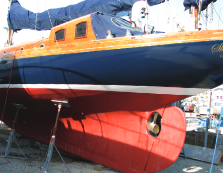
Even long fin keels are not much seen in Australia. An enduring example of a production full keel yacht would be the Fisher 34 or 37/38 built in Mona Vale Sydney some years ago, with a number of well-kept examples sailing today.
Full keel yachts tend to accept heavy weather readily because they were built more solidly: using wood, steel or lots of fibreglass. Fin keels are not new, Herreshoff pioneered the use for inshore racing at the beginning of the 20th century.
But it appears the advent of the fibreglass production yacht almost signalled the end of the full keel and the popularity, at least amongst boatbuilders, of the fin keel. Fin keels come in a variety of forms and the shape has slowly evolved, primarily as yacht designers have had access to better analytical tools.
One major advantage of the fin keel is the simple fact it can be detached, which makes shipping production yachts round the world much cheaper. This, obviously, is a major contributing factor in the popularity.
Fin keels today come in two basic forms: deep or shallow fin, with or without additional bulbs and wings. Earlier fin keeled yachts were sometimes built with bilge or twin, side by side, keels.
Bilge keels allowed yachts to dry out and remain upright but these tended to be restricted to smaller yachts, though there were larger ones. Increased access to marinas and enclosed marinas in areas with big tides, appears to have reduced the popularity amongst modern yacht builders. Bilge keeled yachts tended to heel more than the single keeled equivalents and tacked through larger angles.
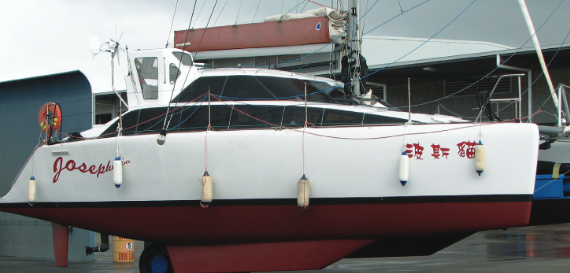
Totally unrelated but multihulls are part of the bilge keeled yacht family with the ability to dry out. Multihulls also have keels to reduce leeway and these are either ‘sacrificial’ mini-keels that will rip off if you ground at speed, or daggerboards. Most cruising catamarans have mini-keels and catamarans with daggerboards that I have cruised with always keep the boards at least part way down to protect propellors and rudders from crab pot lines.
Permanent use of daggerboards appears to negate the use, you might as well have had mini-keels in the first place. Keels are critical to monohulled yachts: they balance the load on the sails so reduce or manage heeling; they reduce leeway, stopping the boat sliding to leeward; and they provide lift counteracting the sideways drive of the sails.
Sadly, monohull keels for cruising yachts are heavy, 25 to 33 percent of overall yacht weight. Plus they restrict the depth to where you can safely travel. Some yacht builders, such as Southerly the better known part of Northshore and Ovni with its alloy yachts, have addressed this shortcoming. The most extreme solution is the lifting keel, the complete keel lifts into a box, manually for smaller keels and hydraulically for larger, usually encased by the saloon table. This is a development that has not proven popular in Australia.
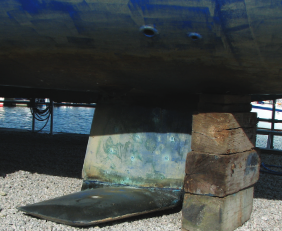
Parker in the UK, who build the International 505 have a 23’ yacht with a lifting keel. When the market was buoyant, they produced larger yachts some with winged lifting keels. Both Elliot and Young, from New Zealand, have had lifting keel designs. Both of these NZ designers also used a lifting keel to allow a yacht to be shipped in a standard shipping container, such as the current Farr 400.
A variant on the lifting keel was a centreboard. The centreboard is effectively a dagger that fits into a base keel and is offered by Jeanneau on some of its Sun Odyssey range. A full lifting keel provides real shoal draft in a monohull, similar to a multihull with mini-keels: 820 millimetre on the 38’ Southerly and 1009mm on its 58’ model; providing the ability to dry out.
These solutions seem neat but a minor problem is maintenance. Moving components, especially underwater, on yachts always generate problems. There have also been problems with fouling of the interior of the box causing the keel to jam.

The longevity of Ovni and Southerly, even in today’s current European economic climate with both brands being expensive, indicates some real success and acceptability. The common solution today to keel design is a shallow or deep fin. Often these are offered as options for the same yacht, sometimes described as a performance or racing keel and the shallower draft version a shallow draft or cruiser keel.
In reality the difference in draft is not great, maybe 300mm to 400mm for an 11m yacht. The difference in performance is marginal, imperceptible to someone cruising but more critical to someone racing. On tests on a 10m yacht the deeper (by 300mm) draft yacht had a 20 degree better tacking angle, less weather helm and heeled about 30 degrees less.
Interestingly, a lifting keel version of the same yacht performed as well as the shallow keeled version, with the bilge keeled version a bit of a dog. Deeper keeled versions of the same cruising yacht will sail better, though you might be pushed to tell the difference. But if your desired cruising area is shallow then a shoal draft keel would obviously be more sensible.
Yachts built specifically for racing have keels that might be considered as extreme, however you want to measure it! Investec Loyal/Maximus has a 20’ keel though the yacht itself is 100’ long. Compare that to the 6’ draft of most larger, around 45’, cruising yachts. Racing yachts also carry protruding torpedo shaped weights at the keel base, ideal for catching crab pot lines or sunfish.
While some racing yachts, when they reach the end of their performance careers, might be considered as the basis for a cruising yacht its keel might be more of a deadweight than intended. Not only state of the art racing yachts are built with protruding bulbs at the base of the keel, many yachts marketed for cruising carry the same sort of handicap. From personal experience a crab pot attached to a short-handed cruising yacht appendage at 2am is not a bundle of laughs.
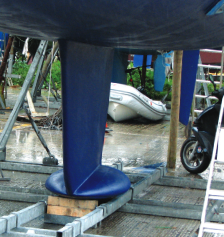
Hanse’s 545 standard keel with forward protruding bulb, for example, has a whopping 9’ draft, is ostensibly sold as a cruising yacht with an interior to match. The Dufour 36 and Beneteau First range also market similarly keeled yachts, but do tend to brand them as performance or racing yachts.
The bulb at the bottom of the fin is the obvious design to enable maximum use of ballast to balance the sail plan: the lower the ballast the less you need carry, which is why racing yachts incorporate such designs. One well-known manifestation of this was the finned keel of Australia II, though technology has moved on. Bulbous bottoms, sometimes tending to fins, have been common on production yachts for a number of years with an enormous breadth of design.
More recently designs have converged. One reason wings lost favour for cruising yachts was their susceptibility to damage when grounding and when grounded, in mud or sand, a large flat bottomed keel was more difficult to free. But Jeanneau nowadays, use the shoal draft wing keel with twin rudders as a way to dry out; so the concept has reputable proponents.
A novel design departure was the tandem keel, two vertical fins with one long interconnecting weight, introduced by Warwick Collins. The idea was to combine shoal draft, ‘full’ keel advantages, a low centre of gravity and produce extra lift, the same as two sails do instead of only one. But the tandem keel has few supporters.
Superficially the tandem keel looks to be a winner, a long shallow keel providing shoal draft and good sea-keeping abilities, but there are obviously technical issues or it would be much more common. Full keels tended to be built hollow and filled with ballast, lead ingots, iron or steel ingots, scrap metal and cemented in place, space left over might be taken up by fuel and water tanks. Modern cruising keels are cast iron or steel with sometimes the inclusion of lead. Lead is 30 percent denser than steel and much more expensive.
Most modern racing yacht keels are built with high tensile steel fins with the ‘torpedo’ weight, sometimes lead but also steel, jointed and bolted, sometimes welded and a flange welded to the top forming a ‘T’ section to allow the keel to be bolted to the hull. Fin keels with a bulb at the bottom are technically the best way to design a keel, as it optimises righting moment or maximises resistance to heeling. Plus, if the fin is thin, minimises drag.
The downside from the cruising yacht point of view is the thinner the fin the more protrusion of the crab pot catcher, the deeper draft and more sensitive directional ability of the yacht.
The very thin fin keels of the high performance racing yacht carry enormous loads and can be made from high tensile steels of the quality produced by the Australian company Bisalloy, coincidentally the same steels used by Manson and Anchor Right for the super high holding power anchors.
Ignoring canting keels, attachment of keels to hulls is by bolts, or studs, through a keel plate in the yacht. Simplistically, the keel is held vertically, the joint surface is liberally coated with marine sealant (FixTech or Sika Flex) the yacht lowered onto the studs in the keel and nuts tightened onto large washers, commonly pieces of stainless steel plate inside the hull and under the cabin sole.
There are two schools of thought regarding how the nuts should be tightened. Some hang the yacht in slings with the keel hanging, others allow the keel to take the full weight of the yacht. The former seems more logical as that is the normal attitude of the yacht in the water with the keel hanging without support.
Given the simplicity with which keels are attached, they are equally easy to remove, arguably more easily than removing the mast. Removing and rebedding a keel is not unknown.
For those who race the keel/hull joint might be faired with epoxy. Castings tend to be a bit rough and steel corrodes, so racing keels are coated and faired and sometimes additionally filled and faired by the owner. If you do ground on something hard and unforgiving it is important to slip the yacht and reseal any damage to the protective coating on the keel and check keel bolts for weepage.
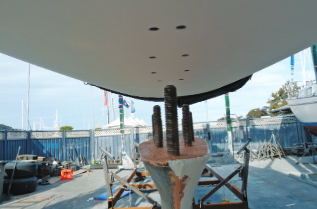
Looking at modern cruise yacht keels from different production yacht builders: Bavaria, Hanse, Beneteau, Jeanneau etcetera, one thing that stands out is that the similarities are greater than any differences. This might explain why keels receive so little mention, they are too similar to differentiate.
Keels tend to have almost vertical leading edges, a tendency to a bulb at the bottom often flattened on the underside to lower the centre of gravity as much as possible, the bulb does not extend forward but does protrude aft of the trailing edge of the keel again keeping the weight low. Bulbs are ‘conventional’, they might have a flattened bottom but no fancy shapes and no fins.
Leading edges of the fin are elliptical and trailing edges narrow, almost to a sharp edge. This gives an indication of what yacht designers, who all have access to the same hydrodynamic data, think is today’s ideal. The optimum draft for a bluewater cruising yacht is 6’. Anymore and there are going to be many places worldwide that you cannot enter; given production yachts today are built for a world market – around 6’ is the limit.
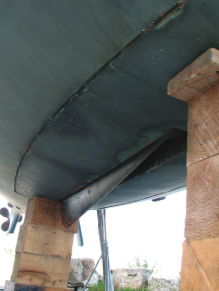
But what is best for you?
Protruding bulbs can catch crab pots, but so too can a near vertical keel leading edge, so some ‘sweepback’ is advantageous. Too much sweepback, common 30 years ago, has been found to be less efficient but again anyone cruising is unlikely to notice. A long keel, fore and aft, will be much more stable when at anchor, but slower to sail. A deeper keel will be more sea kindly, but loses some of its advantage when you run aground in The Great Sandy Strait!
You need to decide what sort of sailing you do. Designers of modern cruising yachts try to make the compromises for you and usually offer two, or occasionally three, keel designs. The very deep draft racing yacht looks sexy and will undoubtedly be fast, but it is usually designed with the idea of crew on the rail.
If you are cruising the crew will be aft in the cockpit, making the yacht slightly stern heavy, so some of the advantage of the fast keel will be lost. Plus you might have the pot catcher and skittish anchored behaviour to contend with. An obvious question to ask: why the inclusion and the detail of racing yacht keels?
Look at the keel of Azurro, it is not much different to today’s cruising yacht keel. Today’s sweep back angles are not so pronounced and our bulbs are bigger but Azurro keels would not be out of place.
Think of Australia II’s winged keel and consider the Parker swing keel illustrated and even today’s shoal draft keel on the Jeanneau Sun Odyssey 379, these modern keels with wings have their genesis with Lexcen and yesterday’s racing yachts. So if performance racing keel technology eventually trickles down to cruising yachts what might we see in the future?
Future forecasts
Investec Loyal’s keel, the 2011 Sydney/Hobart winner, offers a new insight into keel fabrication. The fin is over 6m long, narrowing from 1.0m at the top to 0.7m at the base with an approximate twelve-ton bulb on the bottom, huge loads on such a fine fin. Unlike most, Loyal’s fin is fabricated: 20mm high tensile steel plates, welded, to form a flat hollow tube but including internal longitudinal fillets to add structural strength. The tube is glassed and faired, this makes it hydrodynamic and protects against corrosion.
At the base of the fin is a plate welded at 900 (i.e. it is flat) and this plate is bolted to the torpedo weight with 1.5 inch bolts. Loyal’s keel cants but if it were fixed it could be joined to the hull with a similar plate and bolt arrangement. This method of manufacture is quick and can be completed by anyone with the correct welding skills and, importantly, it works.
The alternative is casting, forging and/or machining; all of which require skills and equipment beyond most boat builders and much more time.
We are not going to see 6m fins but we are already seeing keels similar to today’s shapes, fabricated rather than cast and, as keels come full circle back to the old full keel, that hollow fin may well become the standby fuel tank. With thanks to Noakes and Dovell for sharing the detail on the keel of Investec Loyal.
Jon and his wife Jo have owned their Lightwave 35, Josepheline, for almost 10 years. They manage to get away most years for a long cruise of 3-5 months and more recently their chosen destination has been Tasmania’s west coat.

























